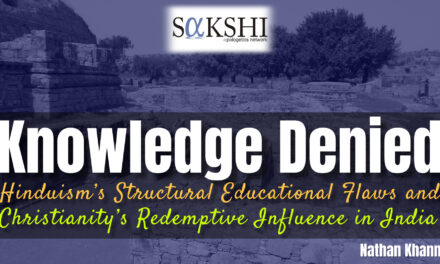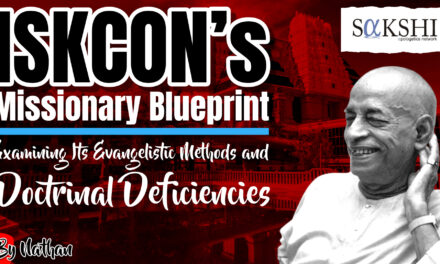 Kalki the 10th incarnation of Vishnu was an historical figure in the guise of Yasodharman. Puranas and poets describe Kalki event as already accomplished. Some Puranas use future tense in order to give the statements an eschatological character. Whatever it be ancient Indians would not write a mundane history within the limits of space and time; they would write only an eternal history presenting an eternal India writes G Suseelan, M. A (Mal), M.A (Philos), M.A (Hist), M.A (Socio), M.L.I.S, B.D and author of Malayalam Bible Dictionary and Malayalam Bible Concordance.
Kalki the 10th incarnation of Vishnu was an historical figure in the guise of Yasodharman. Puranas and poets describe Kalki event as already accomplished. Some Puranas use future tense in order to give the statements an eschatological character. Whatever it be ancient Indians would not write a mundane history within the limits of space and time; they would write only an eternal history presenting an eternal India writes G Suseelan, M. A (Mal), M.A (Philos), M.A (Hist), M.A (Socio), M.L.I.S, B.D and author of Malayalam Bible Dictionary and Malayalam Bible Concordance.
Kalki is still the hope and desire of millions who walk in the path of Dharma, to consummate this evil age of Kali with the protection of the good, the destruction of the wicked and establishment of the sacred law (Bhagavad Gita 4:8).
The widely accepted incarnations of Vishnu are ten in number: a fish, a tortoise, a boar, a man-lion, Vamana (dwarf), Rama (Parasurama), Rama, Krishna, Buddha and Kalki. The Puranic tradition adopted Gautama Buddha into the Brahminic pantheon as Vishnu incarnate by the time of Kumarilabhatha which is roughly the 8th Century A.D. According to A. L. Basham (Basham, AL: The Wonder that was India, P.304), all the incarnations of Vishnu were incorporated by the 11th Century AD.
A work entitled Dharmapariksha by Amitagali, a Digambara Jain, which was completed in 1070 Vikramasamvat enumerated the aforesaid ten incarnations for critical treatment (Bhandarkar, R.G, Collected Works Vol 1, PP 301, 302).
Of Dasavatara, it seems to be the first explicit reference on record. 1070 of Vikrama era corresponds to 1014 A.D. It leads us to the invariable conclusion that the concept of Dasavatara (10 incarnations) took definitive shape between the 8th and 11th century A.D. Kalki is the last of the ten incarnations of Vishnu who will put an end to the present age of Kali and inaugurate the golden age of Krita. Our prime concern here is whether history speaks of Kalki as a fact or as an event (See footnote 1 for discussion on this).
In a derogatory manner, the Jaina Puranas speak of a King Kalki who ruled after Gupta Kings. The Hari Vamsa Purana of Jina Sena says that Kalki had ruled for 40 years and after him Ajitamjayan would rule in Indrapura as King (“Dvi Catvarimsa devatah Kalkirajasyarajata, Tato Ajitamjayo rajasyadindrapura Samstitah” Harivamsam 60:492).
Jina Sena writes in his Uttarapurana (76:395-398) that Kalkiraja was the father and predecessor of Ajitamjaya, that he was a great tyrant who oppressed the world and persecuted the Jaina Community of Nirgranthas and that he reigned for 40 years and he died at the age of 70.
Gunabhadra continues that the great tyrant Kalkiraja was born when 1000 years of Duhsamakala, commencing from the Nirvana of Mahavira, had elapsed. He is said to have been a paramount sovereign (mahimkrtsnam sa bhookshyali) the foremost wicked among all men (dwijanadimah), a perpetrator of sinful deeds (akramakarin) who oppressed the world (udvejitabhutalah). He was the greatest enemy of the Jain community of Nirgranthas who took their meal at noon once a day. If they could not take meal at noon, they would not eat, but wait till next noon for meal. Knowing this Kalkiraja erected an edict that the first lump of food offered to the Jaina community of the first lump of food offered to the Jaina community of Nirgranthas at noon everyday by pious people should be levided as tax.
Consequently, Nirgranthas were exposed to utter starvation. In order to save them from this cruel torture a demon appeared and killed the tyrant Kalki with a thunderbolt and sent him to the hell Retnaprabha, there to live countless ages enduring intolerable pain and agony (Uttarapuruana 76:410-12).
The records of history show that Kalki was to succeed the early Guptas, if he were an historical figure. The next rule after the Guptas belonged to the Huns. The time and deeds of Kalki fit to the Huna King Mihirakula. The great Indologists like K.B. Pathak avowedly acknowledge that Kalki was none other than Mihirakula (Pathak, K B” Commemorative Essays P 215, New Light on Gupta era and Mihirakula.).
The account of Hiune Tsang, who was on his travels a century after the death of Mihirakula, throws further light on this matter. He wrote: “at the time of his (Mihirakula’s) death there were thunder and hail and a thick darkness and the earth shook, and a mighty tempest rages. And the holy saints said this in pity: “for having killed countless victims and overthrown the Law of Buddha, he has now fallen into the lowest hell (maybe Retnaprabha as Gunabhadra said) where he shall pass endless ages of revolution.” Thus the tyrant met the just reward of his evil deeds in another world, if not in this (Smith V: Early history of India, 4th Ed, PP 337, 338).
Howbeit, Mihirakala, a Hun cannot be the Vishnu incarnate. The Hindu Puranic tradition and inscriptions give us another explanation.
As a prologue I shall quote a few scattered lines from ‘the Continent of Circle’. “On the contrary, the barbarians from the Central Asia came as conquerors… Their domination intolerably humiliated the proud Hindu order… The compound of fear, hatred, contempt and humiliation was embodied in the notion of Mlechacha, the unclean and uncivilized foreigner. The Hindus turned to their great preserving god Vishnu for savior and the idea of the tenth incarnation of the god was born. He was Kalki… It is quite possible that an actual Hindu King, Skandagupta or Yaso Dharman, both destroyers of abominable Huns was deified as the Kalki incarnation (Chaudhuri, Nirad C: The Continent of Circle, PP 56, 57). The description of Kalki in the Hindu Puranas cohere wi
th the mighty deeds of King Yasodharman, who is an historical figure.
Was or Will be?
Contrary to the expectation of millions, some Puranas use past tense to describe the Kalki incarnation. The Vayupurana says; ‘Purne Kaliyuga abhavat’ (in the fullness of Kali age, Kalki was born). The Matsyapurana, Jayadeva (12th C A. D) and Chandidasa (a Bengali Poet) use preterit expressions to describe Kalki event. The Bhagavata Purana uses future expressions. But we should not lose sight of the fact that the Matsya and Vayu Puranas are anterior to the Bhagavata.
Kalki and Vishnuyasah
The Vishnu Purana says that Vishnu will be reborn as Kalki in the family of Vishnyasah, a devout Brahmin of Sambhal Village. Endowed with eight superhuman facilities (Ashtaisvarya Siddhi) he will destroy Mlechachhas (Vishnupurana 4:24. 98-100). According to the Vayupurana Kalki has another name Vishnuyasah (Kalkir Vishnuyasah namo parasarya pratapavan). It shows that Vishnuyasah is a synonym of Kalki and, by inference is not the name of his father as the Vishnupurana describes. This kind of displacement of names is not uncommon in the Puranas.
Vishnuyasah and Yasodharman
Yashodharman, (the ruler of Malwa A.D. 51—535, see the footnote 2) delivered the people from the tyranny of Mihirkula. Nothing else is known about either his ancestry or his successors. His name remains alone and unrelated. He is known from only three inscriptions. Two magniloquent inscriptions called the Ranastambhas or the columns of victory erected by Yasodharman help us to find out his identity with Vishnuyasah. The first mandas or inscription bears two names Yasodharman and Visnuvardhana in the title. Fleet treats them as two separate names (Corpus Inscriptionum Indicarum, Vol 111 Plate No 53).
According to him Yasodharman and Vishnuvardhana were not identical; the latter was only a feudatory of the former. On the other hand D. C. Sircar strongly argues for the identity of both (Sircar, Dinesh Chandra: Select Inscriptions bearing on Indian History and Civilization Vol 1).The inscriptions do not permit even an iota of doubt in presenting Yasodharman as Vishnuvardhana.
The Vayupurana says that Kalki has another name Vishnyasah. Vishnuvardhana and Yasodharman must have been coined by compounding the titles of Vardhana and dharman with the names Vishnu and Yasah. On chronological basis I think that probability is on the side of accepting that the Vishnuyasah of the Puranas was coined by adding the first elements of the two names Vishnu/Vardhana and Yaso/dharma. This way of presentation is not alien to our Puranic tradition.
Mighty Deeds of Yasodharman and Kalki
In the Agnipurana (16:46) Kalki is a cavalier carrying bow and arrow. In Kalkipurana, he is mounted on a white horse with a flaming sword in his hand, set out to make war and conquer. He defeats the Jains, Buddhas and the Mlechachhas. Huns were the Mlechchhas to the Hindus. The Huns were defeated and brought to the feet of Yasodharman. Mandasor inscription describes “Yasodharman spurning the limits of his own Kingdom… conquered countries not enjoyed before even by the Guptas… and invaded lands which the chiefs of the Hunas could not penetrate”. Furthermore “Even that King Mihirakula paid him obeisance with complementary presents of the flowers from the lock of hair on the top of his head” (Mandasor Stone Pillar Inscription of Yasodharma Deva 4&6).
In short Kalki the 10th incarnation of Vishnu was an historical figure in the guise of Yasodharman. Puranas and poets describe Kalki event as already accomplished. Some Puranas use future tense in order to give the statements an eschatological character. Whatever it be ancient Indians would not write a mundane history within the limits of space and time; they would write only an eternal history presenting an eternal India. This tendency still persists. So as to get access to real history we have to apply principle of demythologization successfully.
Footnote:
- An historical fact needn’t be an historical event in the strict sense of the term. They are to be treated separately. Unfortunately historians seem to confuse them, which I think is one of the reasons of finding fault with the so accursed unhistorical attitude of Indians.
- The regnal year of Yasodharman is reproduced from the Viswavijinakosa (Vol 9, P761) the basis of which is uncertain.
{moscomment}



